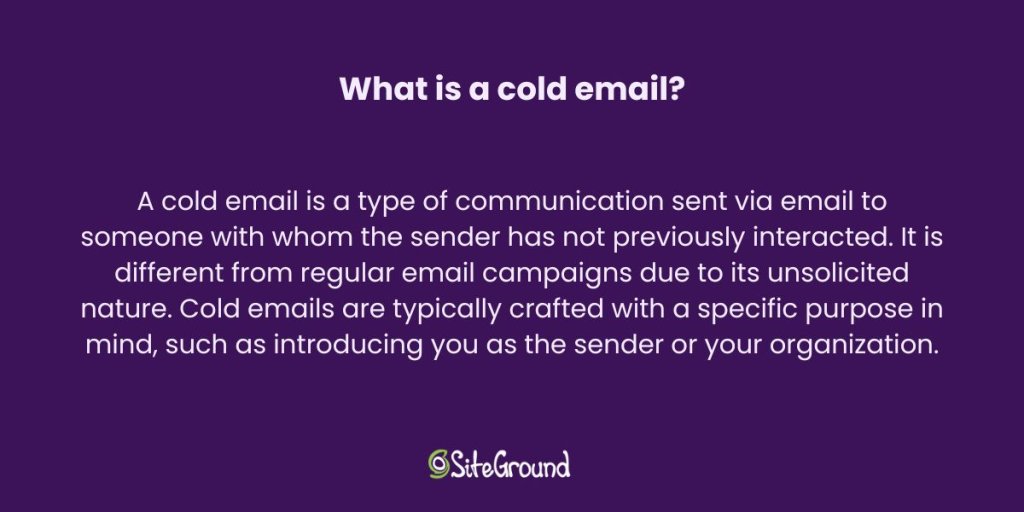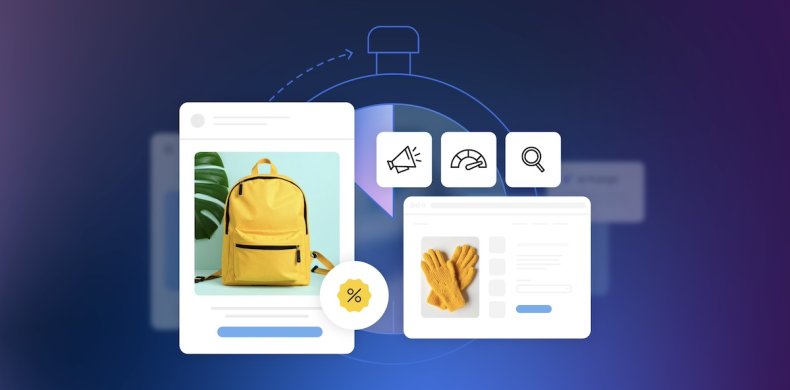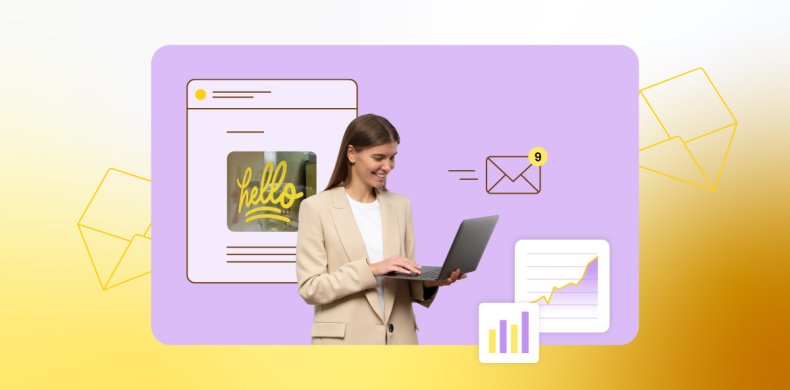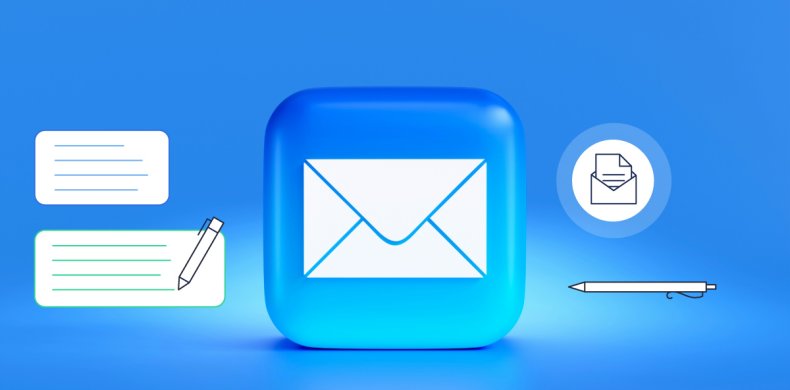
Ever felt like your emails are disappearing into a digital black hole, never to be seen or heard from again? If you’re nodding along, you’re not alone. Cold emailing might sound intimidating, but when done right, it can be your secret weapon for reaching new clients, forging business relationships, and opening doors you never knew existed. Imagine crafting a message so compelling that it cuts through the noise and lands directly in the inbox of your dream contact. Intrigued?
In this guide, we’ll unravel the mystery behind cold emails, showing you how to maximize response rates and turn those cold leads into warm connections. Whether you’re a seasoned pro or just starting out, there’s something here for everyone ready to master the art of cold emailing.
What Is a Cold Email?

A cold email is a type of communication sent to someone with whom the sender has not previously interacted. It’s different from regular email campaigns due to its unsolicited nature, meaning the recipient did not request or expect the email. Cold emails are typically crafted with a specific purpose in mind, such as introducing you and your organization, presenting an idea, or offering your product or service. Whether you’re a business owner seeking to get your product noticed or a freelancer expanding your network, cold emails can be beneficial.
While cold emails can offer significant value, they may feel daunting because you are contacting someone you don’t know. It’s your personal pitch, so crafting an email that’s personable and clear is crucial. You want to sound professional yet approachable, informative yet meaningful.
In essence, a cold email is your first handshake with someone—a way to introduce yourself and start a conversation that could lead to exciting opportunities. If you’ve ever hesitated to send one, consider it a chance to make a new connection. You never know where it might lead!
Is Cold Email Outreach Spam?
Let’s clear the air: cold emails and spam are not the same thing. Sure, both might land in your inbox uninvited, but that’s where the similarities end. Think of spam as the junk mail of the internet—those annoying, irrelevant messages that clutter your inbox and make you roll your eyes. Cold emails, on the other hand, are more like a thoughtful introduction from someone who genuinely wants to connect.
Generally spam emails are sent in bulk with little regard for recipients’ interests, a tactic known as “email blasting.” They’re the equivalent of throwing spaghetti at the wall to see what sticks.
However, this is not what cold emails are. They are carefully crafted and targeted, and sent with a specific purpose and a genuine interest in engaging with the recipient.
To ensure your cold email stands out as professional:
- Respect the recipient’s time and attention by personalizing your message.
- Make sure it’s relevant to the recipient’s business and offers value, such as information, a solution, or a collaboration opportunity.
- Research and understand the recipient’s needs to demonstrate genuine interest.
The line between cold emails and spam is defined by personalization and value. If you send generic messages to a large audience without personalization, you risk crossing into spam territory. However, by investing time in tailoring your message and offering genuine value, your cold email can stand out, fostering positive engagement and building meaningful connections.
What Is the Difference Between Cold Emails and Marketing Emails?
At first glance, cold emails and marketing emails might seem like two peas in a pod—they’re both emails, they’re both used for business purposes, and they both aim to capture the recipient’s attention. However, dig a little deeper, and you’ll find some key differences that set them apart. However cold emails and marketing emails serve distinct purposes and audiences.
Here’s a comparison of these two types of emails:
Cold Emails:
- Serve as the initial point of contact with individuals you have no prior relationship with.
- Are highly targeted and personalized, aiming to initiate a conversation or build a connection.
- Focus on introducing yourself or your business while offering something valuable to the recipient.
- Aim to establish a genuine connection and open the door to future interactions.
- Generate leads by identifying and engaging potential customers who may be interested in your products or services.
- Build partnerships by reaching out to potential collaborators or allies who can mutually benefit from a strategic relationship.
- Promote a new product by informing targeted recipients about your latest offerings and encouraging them to learn more or make a purchase.
- Build links by connecting with industry influencers or websites to enhance your online presence and improve search engine rankings.
Marketing Emails:
- Warm emails are crafted to feel like a friendly conversation with someone familiar with your business, incorporating newsletters or product updates.
- These emails are sent to individuals who have previously interacted with your business to maintain engagement.
- They are integrated into a broader campaign, allowing for more promotional content that aligns with your goals.
- The focus is on nurturing existing relationships, maintaining interest, and encouraging further actions such as making a purchase or signing up for a webinar.
Key Differences
- Cold emails require a higher degree of customization to resonate with individual recipients, as they are tailored to their specific needs and interests.
- Marketing emails, while still personalized to some extent, often rely on segmentation and automation to deliver a consistent message to a larger audience.
How Do You Start and Launch a Cold Email Campaign?
Starting a cold email campaign can be tricky if you’ve never done it before. Cold outreach generally requires a clear pain point, a good subject line and anything that will help you build a personal connection, and eventually bring new customers.
There are a few things we recommend doing when you’re getting started.
1. Set Clear Goals
The first step to any successful marketing campaign is to set clear goals. How else would you know if it’s successful or not?
To increase your chances of running a successful cold email campaign, start by deciding whether you want to:
- Generate leads
- Build partnerships
- Promote a new product
- Build links
Keep in mind that the more boxes you want to tick, the less likely your cold emails are to bring results. You will want to pick only one out of the four options above for the best results.
2. Identify Your Ideal Customer Profile (ICP)
This will help you understand what tone of voice would work best with them, what they might expect from your product or service, and how interested they will be in it.
Begin by pinpointing the traits of your perfect customer, such as their industry, company size, and job roles. This helps you tailor your message to their specific needs. Consider the challenges they face and how your product or service can provide solutions. Knowing what drives their decision-making process is key, as it allows you to craft messages that resonate.
3. Build a Target Audience
With a clear understanding of your ideal customer profile, you can start building a well-defined target audience. Begin by identifying potential leads that match your ICP criteria.
This approach ensures that your efforts are directed towards individuals or businesses that are most likely to benefit from your offerings. Consider segmenting your audience into smaller groups based on specific characteristics or needs. This will allow for more personalized messaging, increasing the likelihood of engagement.
Remember, focusing on a well-defined audience not only optimizes your outreach but also maximizes the value each connection can bring to your business.
4. Get Their Contact Information
In most cases you can find it through LinkedIn. If it isn’t available there, you can use outreach platforms to find most emails you might need. Here it’s important to make sure that you reach out to the right people. That is, if you’re sending a link-building email, you’ll want to reach someone in SEO or PR, not someone in support.
5. Build a Quality Email List
After finding your target audience’s emails, it’s important to organize them into a quality email list. Avoid sending a bunch of generic cold emails to everyone you found. Consider organizing them by position, experience, type of company, or company size. Remember, quality is the main focus here, so it’s important to avoid emails like marketing@company.com or hr@company.com.
Choose a Reliable Email Marketing Platform
Before you start writing cold emails, you’ll need to choose a reliable cold email tool to support your outreach. The right platform can make the process much easier — helping you organize leads, set up workflows, schedule emails, and track performance. All of this contributes to more successful cold email campaigns.
A good email marketing tool also improves deliverability by helping your emails avoid spam filters and land in your prospects’ inboxes. This not only boosts your results but also helps protect your sender reputation.
Use a Cold Email Template
Most email marketing platforms provide a variety of pre-designed templates, making it easier to get started and giving you a general framework for writing cold emails. A well-designed template should be clean, visually appealing, and easy to navigate.
Later in this article, we’ve included several templates you can explore and use.
Once you’ve selected your template, focus on crafting the body of your email. Keep your paragraphs short, use bullet points to highlight key information, and, when relevant, include subheadings to break up the text. Above all, ensure your email feels personalized and doesn’t come across as generic.
Use a Good Subject Line and Preview Text
The email subject line is your first impression, so you’ve got to make it count. Craft a subject line that is intriguing to the recipient, and pair it with compelling preview text that offers a glimpse of what’s inside. Together, they should entice the recipient to open your email and learn more.
Here are five types of subject lines to consider for your next outreach campaign:
- Question-Based: Pose a question to engage curiosity (for example: “Are You Maximizing Your Fleet’s Potential?”).
- Benefit-Driven: Highlight a clear benefit or advantage (for example: “Boost Your Sales with Our Proven Strategy”).
- Curiosity-Inducing: Create intrigue to encourage opens (for example: “The Secret to Doubling Your Efficiency”).
- Personalized: Include the recipient’s name or specific details (for example: “John, Here’s How We Can Help Your Business”).
- Problem-Solving: Address a common pain point (for example: “Struggling with False Reviews? We Can Help”).
Craft a Compelling Message
Your email should be clear, specific, and engaging. Start with an attention-grabbing subject line that piques curiosity. Then, in the body of the email, introduce yourself, explain why you’re reaching out, and highlight the value you can provide.
After that, mention the pain point your product or service addresses. It’s a good idea to include some key details on why your business is the best solution to that specific problem.
Including a clear call to action is crucial, as it can motivate the reader to visit your website, sign up for a newsletter, or simply explore further. Crafting an engaging email call to action can also significantly enhance your email’s effectiveness.
Finally, make sure to personalize each message for the recipient. We’ll get into more detail on what makes a compelling message in the next section.
Personalize
Personalization is key to making your email stand out. Start with a personalized opening line which mentions the recipient’s name, a common connection or a shared experience. This will highlight the relevance of your cold email and proves that you’ve done your homework.
Schedule Smartly
Timing can significantly impact open rates. Experiment with different days and times to find out when your audience is most likely to check their emails. Generally, mid-morning or early afternoon on weekdays are considered optimal times, but it’s always best to test and see what works for your specific audience.
Some email platforms help you understand the best time to send an email by analyzing the open and click-through rates of your previous campaigns.
By focusing on these strategies, you can improve the chances of your cold emails being delivered and opened. Remember, the goal is to create a positive experience for the recipient—one that encourages them to connect with your message and take the next step. With careful planning and attention to detail, you can enhance your email campaign’s effectiveness and achieve your outreach goals.
Plan Your Follow-Ups
Not everyone will respond to your first email, and that’s okay. Plan a series of automated emails to gently remind recipients of your initial message. Keep them short and friendly, and offer additional value or insights to encourage a response.
Make Sure You Comply With Regulations
Before launching or contacting potential customers, ensure that emails comply with regulations, such as GDPR or the CAN-SPAM Act. This includes providing a clear way for recipients to opt out of future communications, as well as including your contact information.
Track and Optimize Your Campaign
Once your campaign is underway, monitor its performance closely. Track metrics such as open rates, response rates, and conversions to see what’s working and what’s not. Use this data to refine your approach and advance future campaigns.
Examples for a Good Cold Email
After all this information you might want to see a few examples of cold emails at play. We’ve put together a few examples to help you understand what makes a strong cold email—and to generate ideas for your own campaign.
The Short and Sweet
Nielsen Norman Group conducted a research on emails that demonstrated that around 80% of adults only scan their emails. What this means for your cold emails is that they should be short, easily scannable, and be direct in what they are saying.
Here’s an example:
Subject line: Helping Your Business Save with Sustainable Energy [highlight the email’s focus and a key business trait]
Hi John, [recipient’s name]
I’m Michael from GreenTech Solutions. [present yourself] We specialize in sustainable energy systems designed to help small businesses reduce energy costs and improve efficiency.
I’d love to schedule a quick 5-minute call to explore how we can support your energy goals and tailor a solution that fits your operations.
Schedule Your Free Consultation [CTA button]
Thanks for your time—I look forward to connecting.
Best,
Michael
The Hook and Proof
You only have a few words to grab your recipient’s attention. A good approach is to start with a bold statement and ask a question. This will spark the reader’s interest and make them want to learn more.
If you choose to open with a bold statement, you need to prove your credibility. One of the best ways to do that is by backing it up with a compelling statistic—just make sure it comes from a reliable source.
Here’s an example:
Subject line: Effective Fleet Solutions for Your Car Hire Business [highlight the email’s focus and a key business trait]
Hey Stefanie [recipient’s name],
Optimized fleet management can drive your sales. How can you attract the right clients?
Simply managing your fleet without a strategy will rarely work. At FleetTech Solutions, we have a proven 25% improvement in fleet efficiency and a 10% reduction in maintenance costs [position yourself as an authority and link to proof]
I believe that your car hire business [recipient’s business] could benefit from our expertise.
Book your 15-minute meeting to know more. [button with call to action]
Regards,
The Tailored Touch
In the realm of outreach, personalization reigns supreme. Crafting an email that resonates with the recipient on a personal level can significantly enhance engagement and open doors to fruitful collaborations.
The example below demonstrates how to effectively tailor a message to the recipient’s unique role and industry, ensuring that the communication feels relevant and valuable.
Subject: Promising SEO Opportunity for Your Business
Hi Mark [recipient’s name],
Jessica [sender’s name] from TechSolutions Innovations here.
Congratulations on your exciting new role at FutureTech Enterprises! It must be an inspiring journey to lead the Product Development Team as it explores new frontiers! [show you know who you’re talking to]
FutureTech’s initiatives demonstrate a strong focus on cutting-edge technology and innovative solutions. [present your company]
Additionally, there’s significant potential in exploring emerging trends like “AI-driven automation tools” (2600 searches) or “next-gen cybersecurity solutions,” which, although having a lower search volume of 400, are gaining traction rapidly. [show you’ve done your research]
The TechSolutions Innovations Team would be thrilled to collaborate on this topic with you, conduct thorough research, and share it with our network to ensure it reaches its full potential.
Would you be open to this idea? I’d love to hear your thoughts. [call-to-action]
Best regards,
The Pain Point
Every business makes money by solving problems. This is exactly what you should present in your cold email. A good approach may be to present the problem your business solves, position yourself as someone trustworthy who can solve it, and then present the solution.
Here’s an example:
Subject line: Take Control of Your Online Reputation Today [engaging hook but not spammy]
Hi Michelle [recipient’s name],
I noticed a few negative comments from people who claim to have used your company’s services.
You may be suffering from hostile competition [the problem you’re solving]. It’s very common that an ill-intended competitor will hire a company to harm your reputation which may lose you customers.
At Reviews 101 [your company’s name] we can help you tackle the problem by responding to negative reviews, pushing your actual customers to leave positive ones, and negotiating with review websites to remove false comments [your solution].
Would you like to hear more about how Reviews 101 [your company’s name] can help you win your good reputation back?
I look forward to discussing how we can support your online reputation. Please let me know if you’d like to schedule a call.
Best regards,
Why Send Cold Emails?

If you’re wondering why cold emails are worth your time, think of them as seeds that, with the right nurturing, can grow into valuable relationships. They’re versatile, efficient, and can open up a world of opportunities. Here’s why you might want to consider adding them to your marketing strategy.
Scalability
One of the biggest advantages of cold emails is their scalability. Unlike face-to-face meetings or phone calls, you can reach a large number of potential contacts without sacrificing the personal touch. Whether you’re targeting ten people or a thousand, cold emails allow you to expand your reach quickly and efficiently. It’s like casting a wide net, but with the precision of a skilled angler.
Automation
Email automation tools allow you to streamline the process, saving you time and effort. You can schedule emails, track responses, and even set follow-up reminders—all with a few clicks. This means you can focus more on crafting the perfect message and less on the logistics of sending it.
Lead Generation
By reaching out to potential clients or partners, you can introduce your product or service to a whole new audience. It’s your chance to get them interested and start a conversation that could lead to a fruitful business relationship. Plus, with the right approach, you can turn cold leads into warm prospects who are eager to know more about what you offer.
Networking
A thoughtful cold email can open the door to valuable relationships. No matter if you’re looking to connect with industry leaders, potential mentors, or like-minded professionals. It’s an opportunity to introduce yourself, share your interests, and explore ways to collaborate.
Link Building
For those in the marketing space, cold emails are an effective way to build backlinks and strengthen your website’s SEO. By reaching out to bloggers, journalists, and influencers, you can pitch guest posts, collaborations, or content sharing opportunities. This not only amplifies your online presence but also helps establish your authority in your niche.
Good for Small Teams
Cold emails allow you to compete with bigger players by leveraging the power of personalized outreach on a budget. With a little creativity and effort, you can make a big impact, reach a wide audience and achieve your business goals.
With so many benefits, cold emails are a powerful tool in your communication arsenal. They offer a unique blend of efficiency and personalization that can help you stand out in a crowded marketplace. Success lies in the details—crafting a resonant message, targeting the right audience, and nurturing the connections you create.
Final Thoughts on Cold Emails
Mastering the art of cold emailing can open up a world of opportunities, from generating leads to building valuable connections. By focusing on personalization, crafting compelling messages, and utilizing smart scheduling, you can have significantly better email deliverability and open rates.
Now that you’re equipped with these insights, why not take your email outreach to the next level? Try SiteGround’s email marketing to streamline your campaigns and achieve remarkable results. Start connecting today!




Comments ( 0 )
Thanks! Your comment will be held for moderation and will be shortly published, if it is related to this blog article. Comments for support inquiries or issues will not be published, if you have such please report it through our official channels of communication.
Leave a comment
Thanks! Your comment will be held for moderation and will be shortly published, if it is related to this blog article. Comments for support inquiries or issues will not be published, if you have such please report it through our official channels of communication.